Continuing from a previous page on this site outlining Canadian Niagara Power’s Rankine generating station (now the Niagara Parks Power Station), this page covers the Sir Adam Beck I (SAB-1) generating station in Queenston, Ontario. I was fortunate to have had a tour of the plant in April of 2008 (organized by the Niagara chapter of the Professional Engineers Ontario). This was an interesting time for the plant which was undergoing a transition from its original 25Hz design to 60Hz. In addition, all generators were being updated for higher output provided by more water – water which once flower through the three plants at the top of the falls and now carried here via a third huge tunnel bored under the city of Niagara Falls, Ontario. SAB-1 was the fourth generating plant in Niagara Falls, Canada, and has been updated considerably since it first appeared on the grid. Today this plant, along with the adjoining SAB-2 station supply a good portion of Ontario with power.
History
The story of this plant begins in 1905, when privately-owned generating stations began appearing at the top of the falls (three were built, or about to be built, that year). Many citizens of Ontario felt that the government should be involved in the generation of power as a ‘free’ resource owned by the people of the province. That year, the issue of public ownership of Niagara power was in the forefront and the Provincial Conservative Party won the election, running on a platform advocating public power. Future privately-owned generating stations were not allowed at Niagara and the government created the Ontario Hydro Electric Power Commission to buy and distribute power for the province. Adam Beck, a key proponent of public ownership of power utilities in Ontario, was appointed commissioner.
As time went on, the commission (run by Beck who was knighted by Britain for his service to the Commonwealth of Canada) began looking at building it’s own power generating station at Niagara instead of simply buying power from the three stations already operating at the top of the falls. In 1917, the commission purchased the Ontario Power Company (and its generating plant located just below the falls) and began construction of a new plant at Queenston. This plant was renamed the Sir Adam Beck Generating Station in 1950 (25 years after Beck’s death).
The commission began by investigating possible locations for new plant. Since the drop of water at Queenston (320 feet) is much larger than that at the falls (about 130 feet), each gallon of water flowing through the SAB plants can produce about three times the output as plants located at the top of the falls. Water from the Niagara river enters the Welland river at Chippawa, flows westward for 6km to a power canal, and another 20km to the forebay at the station in Queenston. Prior to SAB-1, the Welland river flowed naturally eastward – for the new power project the direction of the river would be reversed!
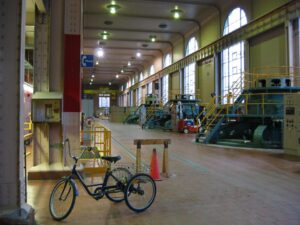 SAB-1 was opened in 1921 and, like all other early plants in Niagara, was a 25Hz plant. It has ten generating units. Today, all the generators have been replaced with modern 60Hz units. In 2008 (when I toured the plant) there were only two remaining generating units operating at 25Hz and those units, too, were slated for conversion to 60Hz in 2009 after the complete discontinuation of 25Hz power in Ontario. In 2008 the plant housed a mixture of old 25Hz generators, modern 60Hz units, and a frequency changer (discussed below).
SAB-1 was opened in 1921 and, like all other early plants in Niagara, was a 25Hz plant. It has ten generating units. Today, all the generators have been replaced with modern 60Hz units. In 2008 (when I toured the plant) there were only two remaining generating units operating at 25Hz and those units, too, were slated for conversion to 60Hz in 2009 after the complete discontinuation of 25Hz power in Ontario. In 2008 the plant housed a mixture of old 25Hz generators, modern 60Hz units, and a frequency changer (discussed below).
The End of 25Hz Power
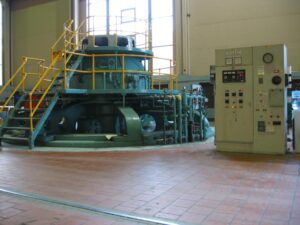 Since 2005, the last privately-owned generating station in Niagara, Canadian Niagara Power’s Rankine plant (described on another page on this site), has sold their water rights to OPG but this left a void in the production of 25Hz power. To handle the 25Hz loads (there are fewer and fewer each year as older equipment was upgraded), SAB-1 had maintained a few 25Hz generating units like the one pictured here from 2008. These old machines were shut down in 2009 and finally, in 2019, the last two 25Hz machines were completely removed (and updated to 60Hz machines) along with associated 25Hz transformers and switchgear.
Since 2005, the last privately-owned generating station in Niagara, Canadian Niagara Power’s Rankine plant (described on another page on this site), has sold their water rights to OPG but this left a void in the production of 25Hz power. To handle the 25Hz loads (there are fewer and fewer each year as older equipment was upgraded), SAB-1 had maintained a few 25Hz generating units like the one pictured here from 2008. These old machines were shut down in 2009 and finally, in 2019, the last two 25Hz machines were completely removed (and updated to 60Hz machines) along with associated 25Hz transformers and switchgear.
SAB-1 also housed the frequency changer which interconnected the 25Hz and 60Hz grids. This unimposing unit was set into the floor of the generating station at the southern end of the plant with the top portion resembling any other unit in the station (like that shown) however underneath it was a large 60Hz induction machine instead of a turbine. It was basically a Motor-Generator (M-G) set consisting of a large 60Hz motor coupled to a 25Hz generator.
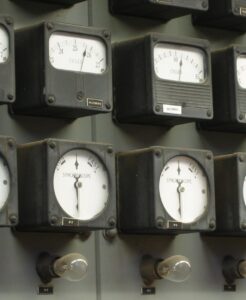
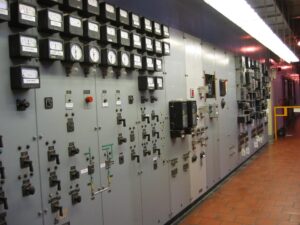 The control panel for the machine is pictured here – a close-up of the controls for the frequency changer reveals frequency meters for both grids (the 25Hz grid on the left, 60Hz on the right) and the synchroscopes allowing the device to be synchronized to each grid separately.
The control panel for the machine is pictured here – a close-up of the controls for the frequency changer reveals frequency meters for both grids (the 25Hz grid on the left, 60Hz on the right) and the synchroscopes allowing the device to be synchronized to each grid separately.
Later, in 1954, a second generating station, SAB-2 was built immediately south of the existing SAB-1 plant. The new 60Hz plant would house 16 generating units and could produce three times the output of the #1 plant (which is still in operation). The plants share the forebay. The original water supply canals for SAB-1, which brought water from the Niagara river via the now-reversed Welland river, and through a large open canal into the forebay, were not nearly large enough to supply water for the new SAB-2 station so two new tunnels were drilled under the city of Niagara Falls to bring extra water from the intakes at Chippawa to the forebay (and now a third tunnel brings even more water, water which originally flowed through the three old plants at the top of the falls) .
The Update Process
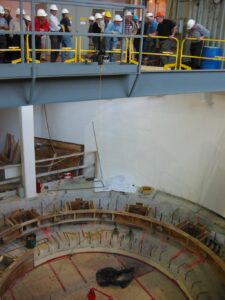
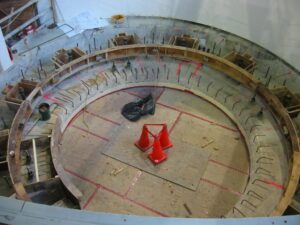 I was fortunate to have been able to visit the plant during the update of the plant to modern, and efficient 60Hz generators and turbines.
I was fortunate to have been able to visit the plant during the update of the plant to modern, and efficient 60Hz generators and turbines.
During the tour, I was afforded a rare glimpse of the retrofit process. The old generator #6 was removed and the site was in the midst of preparation for the new 60Hz generator. The photo to the right reveals the station floor (with the tour group looking on), a large steel-beam catwalk above the hole, and the port where the turbine will be inserted below that, covered in plywood in this case. One floor below the station floor is the subfloor where the stator sits and wiring is connected.
Below that level is the pentstock and turbine (the hole is covered with plywood in this photo). Remedial concrete work is evident here where reinforcing bars and huge bolts (to support the new stator) can be seen protruding from freshly-poured concrete.
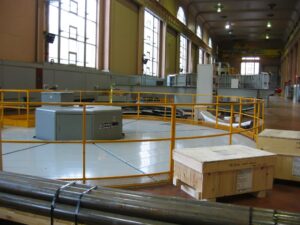 In contrast to the older 25Hz units in which the rear bearing and exciter ring protrudes well above the station floor level, the 60Hz units are buried entirely into the floor of the station and are quite streamlined. In this photo generator unit #5 is seen: built by Canadian General Electric in Peterborough, it is a 63.5MVA unit generating at 13.8kV – incredibly, this single generator alone produces about two-thirds of the total output of the old Rankine generating station which sat at the top of the falls and housed eleven generators. Spinning at 225rpm, this 32-pole generator produces a stator current of 2657A. The generator is excited with 1069A at 156VDC.
In contrast to the older 25Hz units in which the rear bearing and exciter ring protrudes well above the station floor level, the 60Hz units are buried entirely into the floor of the station and are quite streamlined. In this photo generator unit #5 is seen: built by Canadian General Electric in Peterborough, it is a 63.5MVA unit generating at 13.8kV – incredibly, this single generator alone produces about two-thirds of the total output of the old Rankine generating station which sat at the top of the falls and housed eleven generators. Spinning at 225rpm, this 32-pole generator produces a stator current of 2657A. The generator is excited with 1069A at 156VDC.
Immediately behind the generator is the stator for a new generator (probably #6) which will be lowered into the ‘hole’.
Future of the Plant
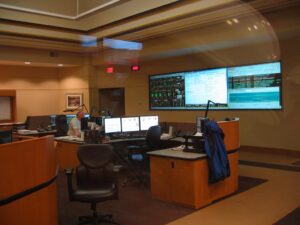 Completely updated, the ten generators at SAB-1 along with sixteen at SAB-2 generate 2GW of electricity for the province of Ontario.
Completely updated, the ten generators at SAB-1 along with sixteen at SAB-2 generate 2GW of electricity for the province of Ontario.
The SAB-1 station also houses the new control room which services both SAB-1 and SAB-2. This modern facility is completely computerized and features a wall-sized display as seen in this photo. The left side of the display shows a summary of all generating units in both plants: sixteen in SAB-2 and ten in SAB-1. The middle panel summarizes notes and comments, and status as well as alarms are shown in the right panel (one warning I had noted was ‘Black Start Diesel fuel low’ … presumably a diesel generator would be used to excite the generators initially should total failure of the grid occur as it did in 1965).
Now that all three original power stations at the top of the falls are idle, water allotments for those plants are channeled to the SAB-1 and 2 stations. Because the drop at Queenston (320 feet) is much larger than that at the falls (about 130 feet), each gallon of water flowing through the SAB plants can produce about three times the output as plants at the top of the falls (this was one reason why the plants at the top of the falls were shut down and why OPG drilled a massive third tunnel under Niagara Falls to bring that water to the SAB stations. The OPG website details current stations.
The Author
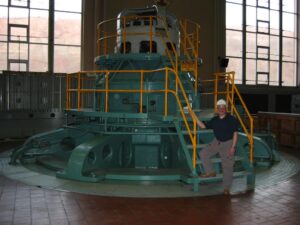
A professional engineer and a retired professor at Niagara College in Canada, my personal interests extend to the history of technology, hence why this place was so intriguing! If you have any comments, feel free to contact and please refer to the ‘Sir Adam Beck’ station on the subject line.
Other tours of Niagara generating stations on this site include the Rankine Generating Station (now the Niagara Parks Power Station), an old 25Hz station from 1905 as well as the Decew Falls Generating Station 110 years old and still operating in Niagara.